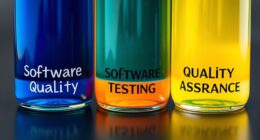At [Company Name], we understand the significance of quality control systems in upholding the dependability and uniformity of products and processes in industrial engineering. These systems are vital for ensuring customer satisfaction, compliance with regulatory standards, and driving the success of our organization.
In this article, we will delve into the world of quality control systems and explore how to optimize their performance. By defining clear and measurable quality objectives, designing suitable control strategies, and implementing reliable systems, we can elevate the efficiency and effectiveness of our quality management practices.
Key Takeaways
- Quality control systems are vital for ensuring the reliability and consistency of products and processes.
- Defining clear and measurable quality objectives is the first step to optimizing the performance of automated quality control systems.
- Designing appropriate quality control strategies, such as statistical process control and defect analysis, enhances system efficiency.
- Implementing calibrated and validated hardware, software, and sensors is crucial for reliable quality control systems.
- Monitoring performance through data analysis allows for continuous improvement and alignment with quality objectives.
Defining Clear and Measurable Quality Objectives
In order to optimize the performance of our automated quality control systems, it is crucial to define clear and measurable quality objectives. These objectives serve as our guiding principles and help us ensure that our products and processes meet the highest standards of quality.
When defining quality objectives, we take into consideration various factors that influence our customers’ requirements, regulatory standards, and organizational goals. By aligning our quality objectives with these key elements, we can establish a solid foundation for our quality control systems.
Clear and measurable quality objectives allow us to set specific targets and benchmarks for evaluating the performance of our automated quality control systems. They provide us with the criteria and indicators we need to assess whether our products and processes are meeting the desired level of quality.
By regularly evaluating our performance against these quality objectives, we can identify areas for improvement and implement corrective measures to enhance the efficiency and effectiveness of our quality control systems.
Benefits of Defining Quality Objectives
- Provides a clear direction for our quality control efforts
- Ensures alignment with customer requirements
- Helps us comply with regulatory standards
- Supports the achievement of organizational goals
- Facilitates continuous improvement of our processes and products
When we have clearly defined quality objectives, we can measure our progress and make informed decisions to drive improvements. Our quality control systems become more focused, efficient, and capable of delivering products and services that consistently meet or exceed customer expectations.
“Defining clear and measurable quality objectives is the foundation for optimizing the performance of our automated quality control systems.”
By establishing quality objectives that are synchronized with our customer requirements, regulatory standards, and organizational goals, we can effectively enhance the quality of our products and processes while continuously improving our overall performance.
Designing Quality Control Strategies
Once you have established clear and measurable quality objectives, the next step is to design effective quality control strategies tailored to your specific products and processes. These strategies play a crucial role in ensuring that your automated quality control systems are optimized for accuracy and efficiency.
-
- Statistical Process Control (SPC):
SPC is a powerful quality control technique that uses statistical methods to monitor and control processes. By analyzing data collected over time, SPC identifies patterns, trends, and variations, allowing you to proactively make adjustments to maintain consistent quality.
-
- Acceptance Sampling:
Acceptance sampling involves inspecting a sample of products from a larger batch to determine if it meets predetermined quality standards. This strategy provides a cost-effective way to assess the overall quality of a batch without inspecting each individual unit.
-
- Inspection Plans:
Inspection plans outline the specific procedures and criteria for quality inspections at various stages of the production process. These plans ensure that all necessary inspections are performed consistently and that any deviations from quality standards are promptly identified and addressed.
-
- Defect Analysis:
Defect analysis involves analyzing and categorizing defects or non-conforming units to identify their root causes. By understanding the underlying reasons for defects, you can implement targeted corrective actions to prevent their recurrence.
When choosing the most appropriate quality control strategy for your automated systems, it is important to consider several factors, including cost, efficiency, and accuracy. By carefully evaluating these factors, you can select the strategy that best aligns with your organizational goals and enables you to achieve the desired level of product quality.
An Illustration of Quality Control Strategies in Action
We implemented statistical process control (SPC) as part of our quality control strategy for our automotive assembly line. By monitoring key process parameters and analyzing the data collected, we were able to identify trends and variations that could potentially lead to defects. This allowed us to make timely adjustments and ensure consistent quality throughout the production process. The use of SPC helped us reduce defect rates by 30% and improve customer satisfaction.
| Quality Control Strategy | Description |
|---|---|
| Statistical Process Control (SPC) | Monitors and controls processes using statistical methods to identify variations and make timely adjustments |
| Acceptance Sampling | Inspects a sample from a batch to assess overall quality without inspecting each individual unit |
| Inspection Plans | Outlines specific procedures and criteria for quality inspections at different production stages |
| Defect Analysis | Analyzes and categorizes defects to identify root causes and implement targeted corrective actions |
Implementing Quality Control Systems
The third step in optimizing your quality control systems is to implement the necessary hardware, software, and sensors. These components are essential for the efficient operation and accurate measurement of your quality control processes.
When choosing hardware, consider factors such as compatibility with existing systems, durability, and reliability. Selecting high-quality software is crucial for seamless integration and user-friendly interfaces. Sensors play a vital role in capturing data and providing real-time feedback, so ensure their accuracy and precision.
Once the hardware, software, and sensors are in place, it is crucial to calibrate and validate the systems regularly. Calibration ensures that measurements are accurate and consistent, while validation confirms that the systems meet the required performance standards. Regular maintenance also helps in detecting and resolving any issues promptly.
“Implementing quality control systems with calibrated and validated hardware, software, and sensors is vital for reliable and consistent results.”
Training your staff on how to effectively use and operate the quality control systems is equally important. Provide comprehensive training sessions to ensure that all personnel understand the processes, procedures, and functionalities of the systems. This training will empower your employees to utilize the quality control systems to their full potential.
Investing in comprehensive training and ongoing support will not only enhance the performance of your quality control systems but also promote a culture of excellence and continuous improvement within your organization.
Monitoring Quality Control Performance
Monitoring the performance of your quality control systems is crucial to ensure the effectiveness and efficiency of your processes. By collecting and analyzing data and feedback, you can gain valuable insights into the performance of your automated quality control systems.
In order to monitor your quality control performance, it is important to utilize statistical methods and tools to measure and visualize important quality indicators. These indicators include defect rates, process capability, yield, and customer satisfaction. Through data analysis, you can identify patterns, trends, and areas of improvement to optimize your quality control processes.
Statistical Methods for Quality Control Performance Monitoring
Statistical methods play a vital role in measuring and analyzing quality control performance. Some commonly used statistical methods include:
- Control charts: These charts visually represent data over time, allowing you to identify variation and detect process shifts or abnormalities.
- Histograms: Histograms provide a visual representation of the distribution of defect rates or other quality indicators, helping you understand the spread and frequency of different outcomes.
- Pareto analysis: This technique helps you prioritize and focus on the most critical defects or quality issues by analyzing their frequency and impact.
- Regression analysis: Regression analysis allows you to understand the relationship between different variables and identify the factors that impact quality control performance.
By leveraging these statistical methods, you can gain insights into the root causes of quality issues, make data-driven decisions, and implement effective corrective actions.
Comparing Actual Performance with Expected Performance
When monitoring quality control performance, it is important to compare the actual performance of your automated quality control systems with the expected performance based on your defined quality objectives. This helps you identify any gaps or deviations and take necessary actions to bridge those gaps.
For example, you can compare the defect rates observed in your production process with the target defect rates defined in your quality objectives. If the actual defect rates are higher than expected, you can investigate the causes, such as process variations or equipment malfunctions, and implement corrective measures to reduce defects and improve quality.
Similarly, comparing process capability indices, such as Cp or Cpk, with your desired values can give you insights into the capability of your processes to meet customer requirements. If the process capability falls below expectations, you can identify the root causes and implement process improvements to enhance capability.
Monitoring customer satisfaction is another crucial aspect of quality control performance. By regularly analyzing customer feedback and satisfaction metrics, such as Net Promoter Score (NPS) or customer loyalty indices, you can identify areas for improvement and take proactive measures to enhance customer satisfaction and loyalty.
Remember, monitoring quality control performance is an ongoing process that requires continuous data analysis, feedback analysis, and improvement efforts. By implementing robust monitoring practices, you can ensure that your quality control systems are optimized and aligned with your quality objectives.

Improving Quality Control Processes
Once you have implemented your automated quality control systems and established a monitoring process, the next step is to focus on improving the quality control processes. Continuous improvement is essential for enhancing product quality and customer satisfaction.
To improve quality control processes, we recommend implementing corrective and preventive actions. By using systematic and structured approaches, such as the Plan-Do-Check-Act (PDCA) cycle, root cause analysis, or the Six Sigma methodology, you can identify and eliminate the causes of poor quality.
During the PDCA cycle, you will:
- Plan: Define your quality objectives, determine the best approach to achieve them, and develop a plan for implementing corrective and preventive actions.
- Do: Implement the planned actions and collect data to evaluate their effectiveness.
- Check: Analyze the data collected and assess whether the implemented actions have resulted in the desired improvements.
- Act: Based on the analysis and evaluation, adjust the processes further, if needed, and standardize the improved practices.
In addition to the PDCA cycle, root cause analysis is a valuable tool for identifying the underlying issues causing quality problems. By determining the root causes, you can implement targeted corrective actions to prevent similar issues from recurring.
The Six Sigma methodology, widely used in quality management, focuses on reducing process variation and defects. By applying statistical techniques and tools, Six Sigma helps organizations achieve a high level of process capability and waste reduction.
It is important to involve your staff, customers, and suppliers in the improvement process. Their valuable feedback and suggestions can provide insights into potential areas for improvement.
Tailoring Control Systems to Industry Specifics
Different industries and processes have unique control requirements. When it comes to control systems, there are different types that can be tailored to suit specific industry needs. Let’s take a closer look at the various control system types: open-loop control, closed-loop control, feedback control, and feedforward control.
Open-loop Control
Open-loop control, also known as manual control, is a type of control system where the output is not influenced by the system’s performance. The control action is predetermined and does not rely on feedback. It is commonly used in simple and repetitive processes that do not require constant adjustments.
Closed-loop Control
Closed-loop control, also known as automatic control, is a more advanced type of control system that uses feedback to regulate the output. It continuously compares the desired output with the actual output and makes adjustments accordingly. Closed-loop control is ideal for processes that require precise control and stability.
Feedback Control
Feedback control is a type of closed-loop control system that uses feedback signals to make adjustments. It constantly monitors the output and compares it to the desired value. If there is a deviation, the system takes corrective action to bring the output back to the desired value. Feedback control is widely used in various industries, such as manufacturing, aerospace, and robotics.
Feedforward Control
Feedforward control is another type of closed-loop control system that anticipates disturbances before they affect the output. It uses predictive models and measurements of the disturbances to make adjustments in advance. Feedforward control is effective in mitigating the impact of external factors on the system’s performance and is commonly used in industries where precise control is critical, such as chemical processing and power generation.
When choosing a control system for your industry, it’s important to consider the specific needs and requirements of your application. Each control system type has its advantages and limitations, so it’s crucial to select the one that aligns with your operational goals and regulatory standards.
To summarize:
| Control System Type | Key Features | Industry Application |
|---|---|---|
| Open-loop control | Predefined control action, no feedback | Simple and repetitive processes |
| Closed-loop control | Feedback-driven adjustments | Precise control and stability |
| Feedback control | Compares desired output with actual output | Manufacturing, aerospace, robotics |
| Feedforward control | Anticipates disturbances, predictive models | Chemical processing, power generation |

Components and Selection Criteria for Control Systems
Control systems are composed of various components that work together to optimize performance and ensure efficient operations. These components include sensors, actuators, controllers, and communication interfaces. When selecting a control system for your application, it is essential to consider several factors to meet your specific requirements effectively.
Selecting Sensors
Sensors play a crucial role in measuring physical quantities and converting them into electrical signals. When choosing sensors for your control system, consider their precision, accuracy, and compatibility with the variables you need to monitor. It’s important to select sensors that can reliably capture data and provide real-time feedback to ensure accurate control and decision-making.
Optimizing Actuators
Actuators are responsible for converting electrical signals into physical actions or movements. The selection of actuators should align with your application’s requirements in terms of force, speed, and precision. It is important to choose actuators that can operate reliably and efficiently to ensure optimal performance and system responsiveness.
Controllers for Enhanced Control
Controllers play a crucial role in processing sensor data and generating control signals to regulate the performance of your system. When selecting controllers, consider their scalability, reliability, and compatibility with your control algorithm. It is essential to choose controllers that can handle the complexity of your application while providing precise control over your processes.
Effective Communication Interfaces
Communication interfaces facilitate the exchange of data and instructions between different components of the control system. When selecting communication interfaces, consider compatibility with existing communication protocols and industry standards. Reliable and fast communication is vital to ensure seamless integration and coordination among the various components of your control system.
“The selection of high-quality components is crucial for enhancing accuracy, speed, and overall system efficiency.”
When deciding on the components for your control system, precision, scalability, reliability, and cost should be considered. The level of precision required for your application will dictate the selection of sensors and controllers. Scalability ensures that your control system can accommodate future growth and expansion. Reliability is critical for uninterrupted operations and minimizing downtime. Finally, cost considerations should align with budgetary constraints while maintaining quality and performance standards.
By carefully selecting the right components based on these criteria, you can ensure that your control system operates optimally, fulfilling your application’s requirements with precision, scalability, reliability, and cost-effectiveness.
Conclusion
Optimizing quality control systems and processes is essential for achieving efficiency and excellence in product quality. By defining clear quality objectives, designing appropriate control strategies, implementing reliable quality control systems, and continuously monitoring and improving performance, organizations can ensure optimal results.
To achieve continuous improvement, it is crucial to engage the quality team and prioritize resource allocation. The quality team plays a vital role in driving the implementation of quality control systems and processes, constantly seeking opportunities for enhancement. Their expertise and dedication contribute to the success of the organization’s quality management resources.
Continuous improvement is an ongoing journey that requires a commitment from all stakeholders involved. By fostering a culture of continuous improvement and encouraging feedback and suggestions from employees, customers, and suppliers, organizations can identify areas for enhancement and drive impactful changes.
FAQ
Why are quality control systems important in industrial engineering?
Quality control systems are essential for ensuring the reliability and consistency of products and processes in industrial engineering. They help organizations meet customer requirements, regulatory standards, and internal goals.
How can I optimize the performance of my automated quality control systems?
To optimize the performance of your automated quality control systems, start by defining clear and measurable quality objectives. Then, design quality control strategies that suit your products and processes. Implement the necessary hardware, software, and sensors, and regularly calibrate and validate your systems. Monitor performance using data analysis and feedback, and continuously improve processes through corrective and preventive actions.
What factors should I consider when choosing a quality control strategy?
When choosing a quality control strategy for your automated systems, consider factors such as cost, efficiency, and accuracy. The strategy should be suitable for the type and complexity of your products and processes. It can include statistical process control, acceptance sampling, inspection plans, or defect analysis, among others.
How do I ensure the reliability of my quality control systems?
To ensure the reliability of your quality control systems, it is important to calibrate, validate, and maintain them regularly. This includes setting up the necessary hardware, software, and sensors, and training your staff on how to use and operate the systems effectively.
How can I monitor the performance of my quality control systems?
You can monitor the performance of your quality control systems by collecting and analyzing data and feedback. Use statistical methods and tools to measure quality indicators such as defect rates, process capability, yield, and customer satisfaction. Compare the actual performance with the expected performance based on your quality objectives to identify any gaps or deviations.
What are some best practices for improving quality control processes?
Some best practices for improving quality control processes include implementing corrective and preventive actions, using systematic approaches like the Plan-Do-Check-Act cycle, conducting root cause analysis, and applying methodologies like Six Sigma. It is also important to involve your staff, customers, and suppliers in the improvement process and encourage their feedback and suggestions.
How do I choose the right control system for my industry?
When choosing a control system for your industry, consider the specific needs and requirements of your application and regulatory standards. Control systems can be categorized into open-loop control, closed-loop control, feedback control, and feedforward control. Select a system that is suitable and tailored to your industry’s unique control requirements.
What are the important components and selection criteria for control systems?
Control systems consist of components such as sensors, actuators, controllers, and communication interfaces. When selecting a control system, consider factors such as precision requirements, scalability, reliability, and cost. Choose high-quality components that enhance accuracy, speed, and overall system efficiency.
How can I optimize my quality management resources and achieve continuous improvement?
To optimize quality management resources and achieve continuous improvement, engage your quality team and prioritize resource allocation. Continuously monitor and improve the performance of your quality control systems, involve key stakeholders in the improvement process, and encourage feedback and suggestions.









